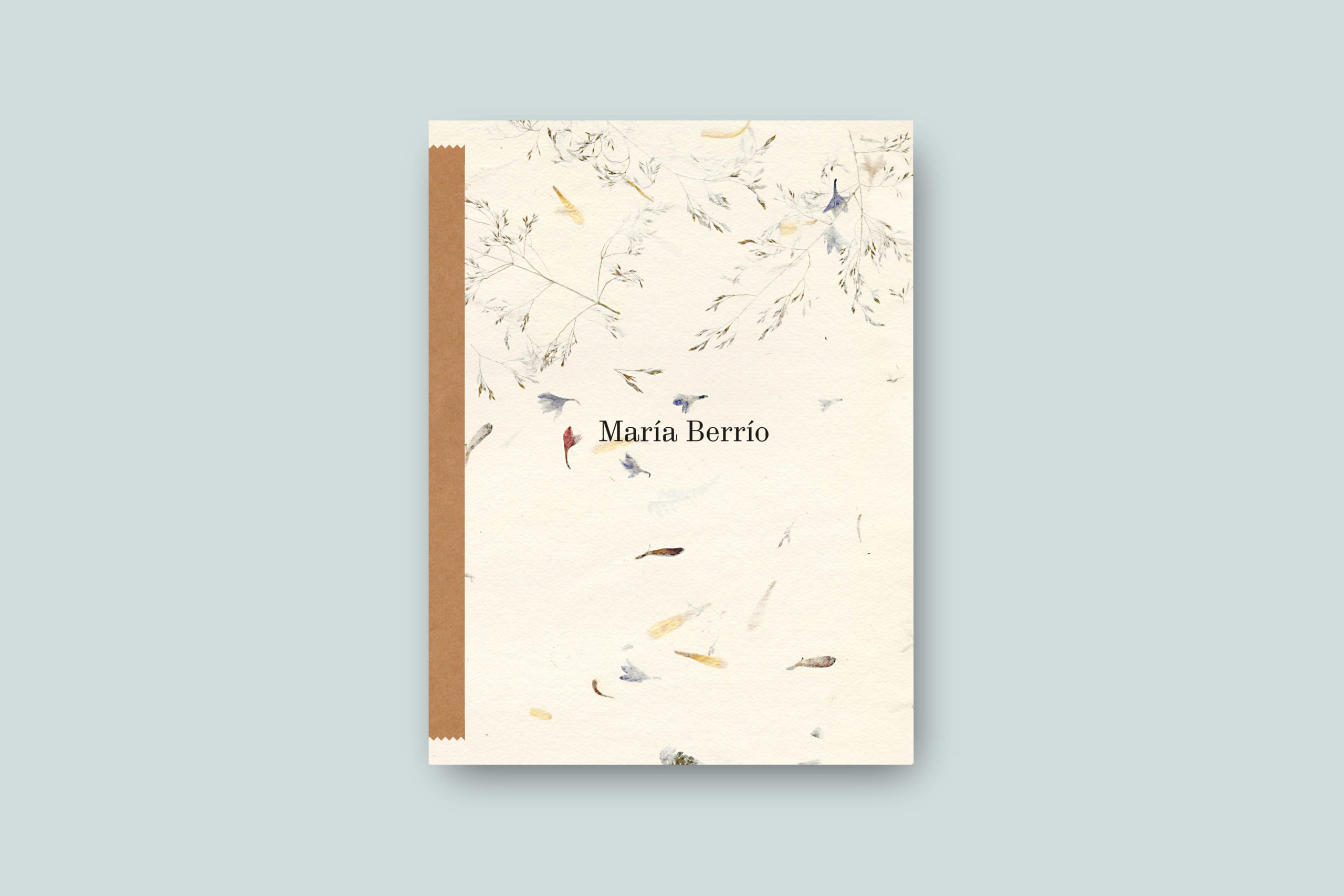María Berrío: The End of Ritual
21 November 2024–18 January 2025
16 Wharf Road, London N1 7RW
Tuesday–Saturday: 10am–6pm
The End of Ritual depicts moments of disquiet articulated within densely populated interiors, spaces where the old world meets the new and a restless dynamic unfolds between performers and spectators in and out of the frame.
María Berrío is celebrated for works that draw upon aspects of mythology and folklore to create narratives that address contemporary issues of identity, agency, and survival, particularly those experienced by women and children in the face of overwhelming ecological, economic or geo-political forces. These new works take place in often crowded interiors, where some characters appear governed by mysterious forces, while others go about their business unconcerned. For the first time, she has collaborated with dancers – from the New York City-based GALLIM contemporary dance company – who, supplied with masks and costumes from the artist’s collection, were invited to improvise movements which fed into Berrío’s working process.
Aspects of fantasy, masquerade, history and our frenetic present are woven together, while the artist’s blending of Japanese papers and watercolour, tender and tactile but always with the turbulent splice of collage as a resounding echo, further articulates the work’s fractured narratives. The results are something like a vibrant, surreal folktale or, as Siddhartha Mitter defines in his essay for the accompanying publication, ‘the fabric of dreams – no longer their unfurled narratives, but the rough and hectic machinery of their making, the way in which signs, memories and allusions escape the category fetters of the rational mind and collide in unquiet sleep.’
Film by Gautier Deblonde, María Berrío’s studio, summer 2024
Maria 2 (Maria first quote)
‘The End of Ritual examines what happens when history is forgotten and rituals become drained of any meaning. Things, once of real relevance, become merely things to be acted out, devoid of substance, and leave those performing the rituals at a loss as to what is the true meaning behind them.’
— María Berrío, quoted from the accompanying publication
Maria 1 (Siddhartha quote 1)
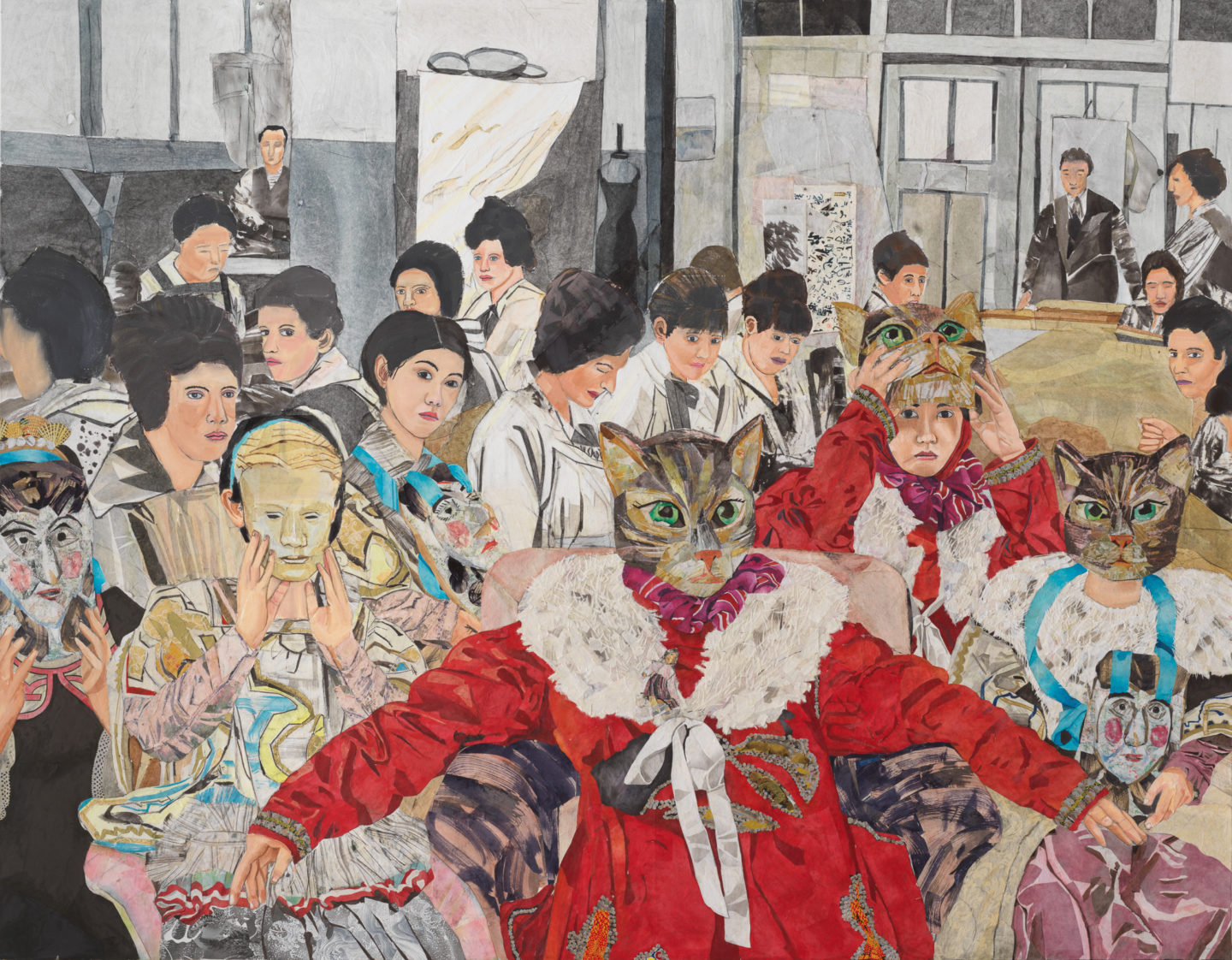
Collage with Japanese papers and watercolour paint on canvas
233.7 x 299.7 cm
92 x 118 in
María Berrío, The Spectators, 2024
More info‘Never before has Berrío drawn us so close, invested her figures with this physical power that projects out and scrambles our sensory field. It’s almost aggressive – an interpellation. The tumult on canvas proceeds from a compositional method but addresses the tumult of the world.’ — Siddhartha Mitter, quoted from A Call to the Stage, his essay for the accompanying publication
Maria 3 (Memento Vivere)
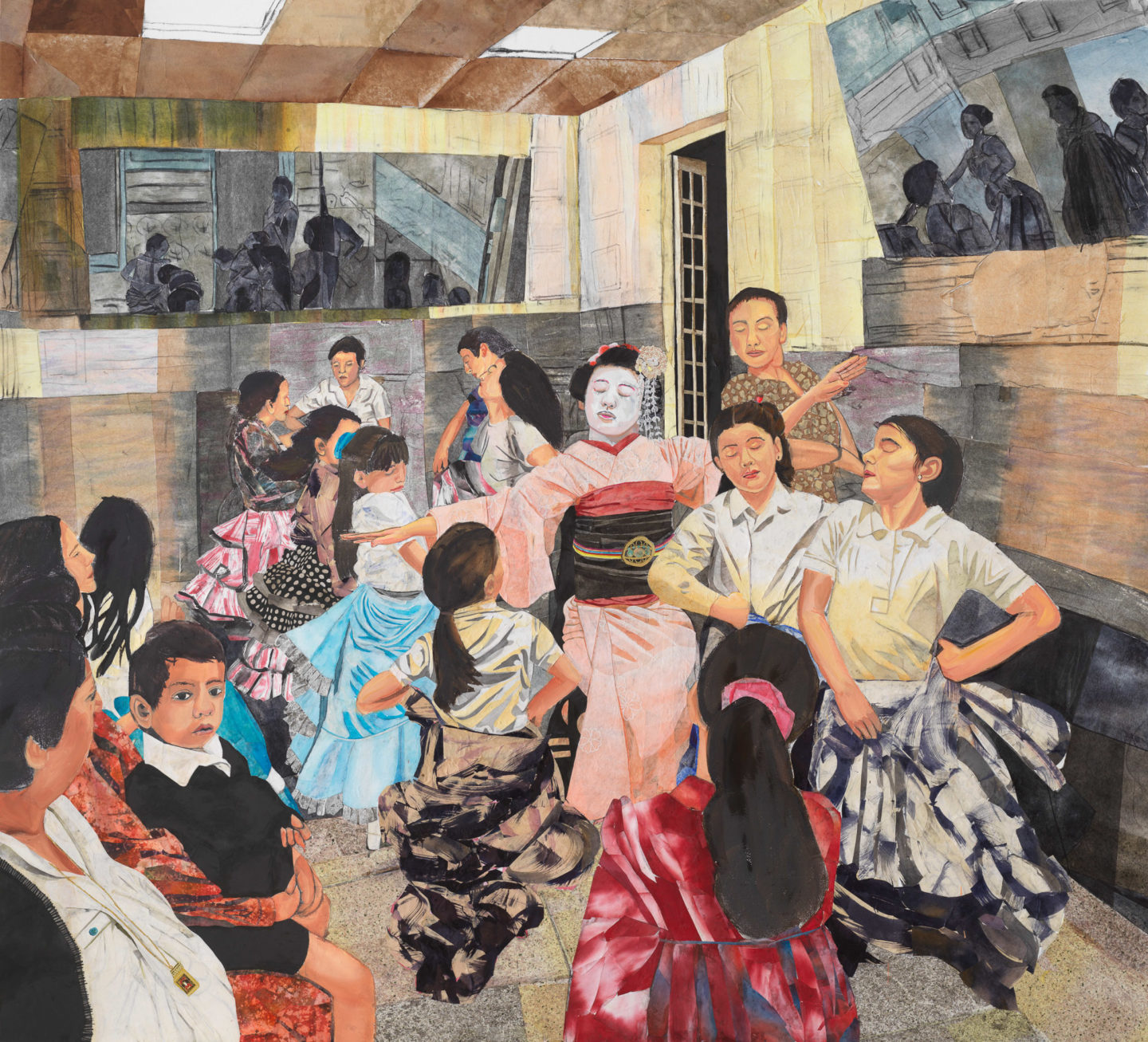
Collage with Japanese papers and watercolour paint on canvas
271.1 x 297.8 cm
106 3/4 x 117 1/4 in
María Berrío, Memento Vivere, 2024
More info‘One child casts his glance askance, as if prompting us to notice what only he so far has seen.’
— Siddhartha Mitter
‘… A dancing geisha in her elegant kimono wears the same trance-like expression as the people who sway with her or cluster to the side – some watching, some distracted. The room around them seems built from coarse wood planks, with high suspended mirrors that relay their motions back in shadowy greys. One child casts his glance askance, as if prompting us to notice what only he so far has seen.’
Maria 4 (Eldorado)
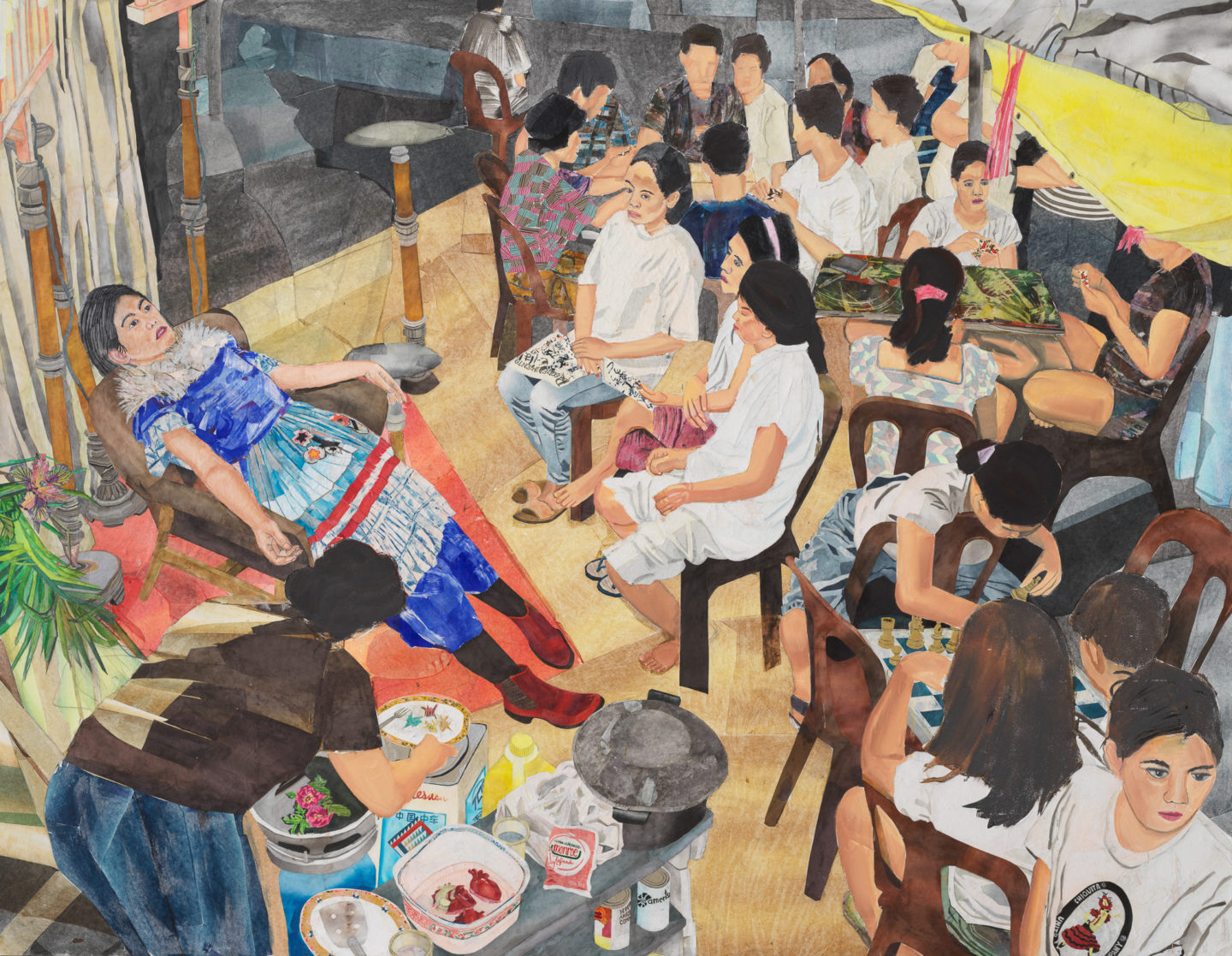
Collage with Japanese papers and watercolour paint on canvas
233.7 x 299.7 cm
92 x 118 in
María Berrío, El Dorado, 2024
More info‘For all their reverie and mystery, Berrío grounds her scenarios in hard social fact.’ — Siddhartha Mitter
‘A kind of hubbub prevails in El Dorado… The woman who focuses the scene sprawls on an armchair that, like her patterned dress and ruffled collar, distinguishes her from the more casually-clad characters… Here again, a young character’s outward gaze directs us back out of the frame. But first we notice her T-shirt, which advertises Chiquita bananas. It’s the kind of cheap branded apparel you’d see in any market town in the Global South, but the reference is heavy. The erstwhile United Fruit Company was long a force in Colombia, backed by the local and United States governments; the 1928 massacre of its striking plantation workers is a traumatic historical episode that appears, fictionalised, in Gabriel García Márquez’s One Hundred Years of Solitude. For all their reverie and mystery, Berrío grounds her scenarios in hard social fact, through the spare but pointed use of this kind of detail.’
Maria 5 (Maria Mons quote)
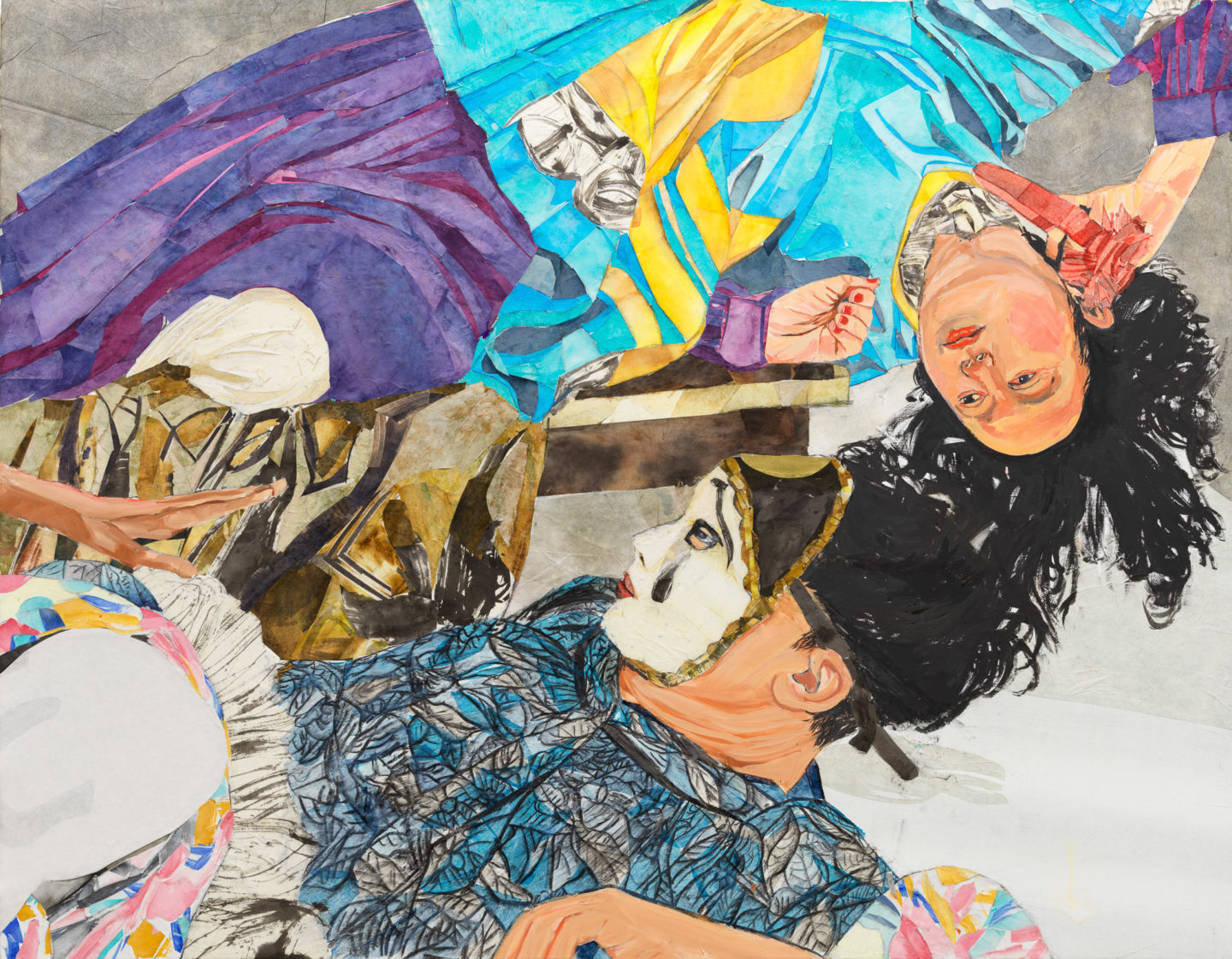
Collage with Japanese papers and watercolour paint on linen
142.2 x 182.9 cm
56 x 72 in
María Berrío, Arsia Mons, 2024
More info‘The past has become a lifeless world, as far away from our present in time as the Red Planet is from us in distance.’ — María Berrío
‘Some titles are taken from Martian moons and topography — Arsia Mons, Elysium Mons… The past has become a lifeless world, as far away from our present in time as the Red Planet is from us in distance. It is alien and far removed, and all that is left are props and costumes.’
Maria 8 (Deimos)

Collage with Japanese papers and watercolour paint on linen
125.7 x 94.6 cm
49 1/2 x 37 1/4 in
María Berrío, Deimos, 2024
More info‘In the paintings the figures seem to manoeuvre the outfits and masks, fiddle and search for the fit. They are testing history, in a sense – investing accoutrements of past ritual in the uncertain hope for present meaning.’
— Siddhartha Mitter
Maria Cheyava Falls
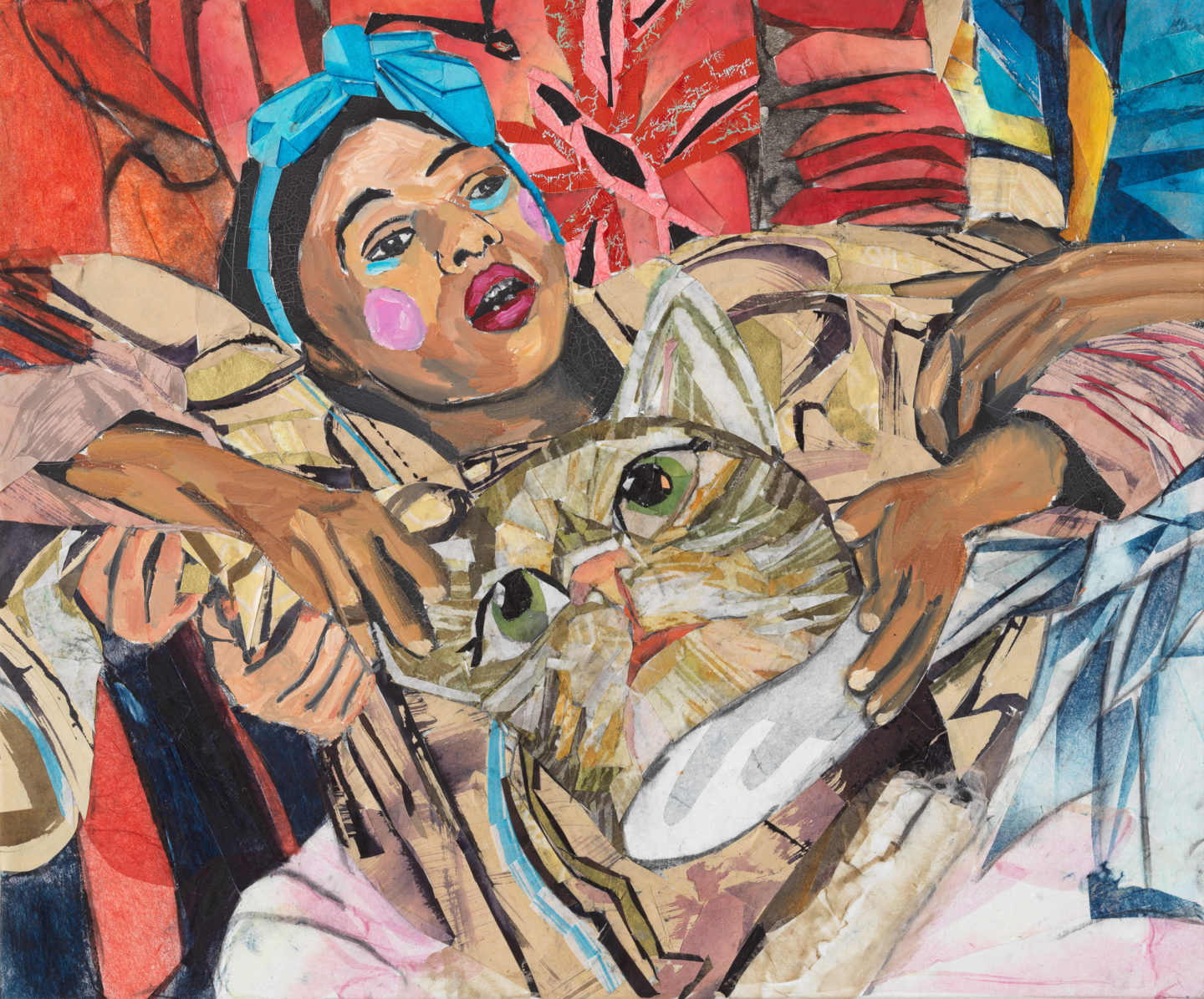
Collage with Japanese papers and watercolour paint on linen
50.8 x 61 cm
20 x 24 in
María Berrío, Cheyava Falls, 2024
More infoMaria 7
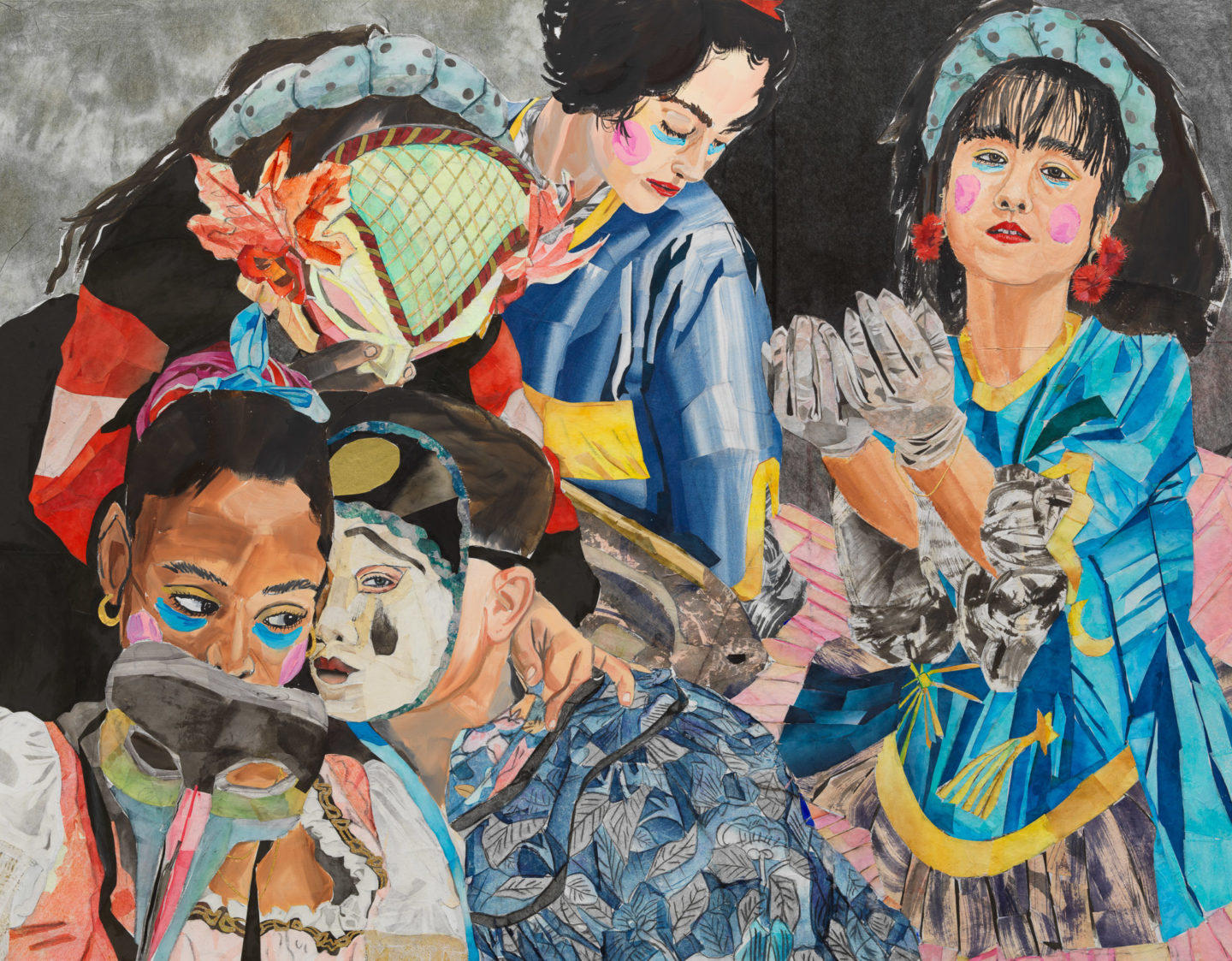
Collage with Japanese papers and watercolour paint on linen
142.4 x 182.9 cm
56 x 72 in
María Berrío, Anseris Mons, 2024
More info‘We are a species that needs a narrative to order life in a meaningful way.’ — María Berrío
‘We are a species that needs a narrative to order life in a meaningful way. Origins and stories with beginnings-middles-ends, milestones and landmarks. We are losing the stories which once gave us that structure. But the dancers, given only a handful of props and little direction, evoked something primal and essential, regardless… Ritual, it seemed, is something we can shape anew.’
Maria 6 (Elysium Mons)

Collage with Japanese papers and watercolour paint on linen
142.2 x 182.9 cm
56 x 72 in
María Berrío, Elysium Mons, 2024
More info‘These paintings are a call to motion and movement. They want us to take cognisance of the forces that would turn us into spectators…’
— Siddhartha Mitter
Maria 9
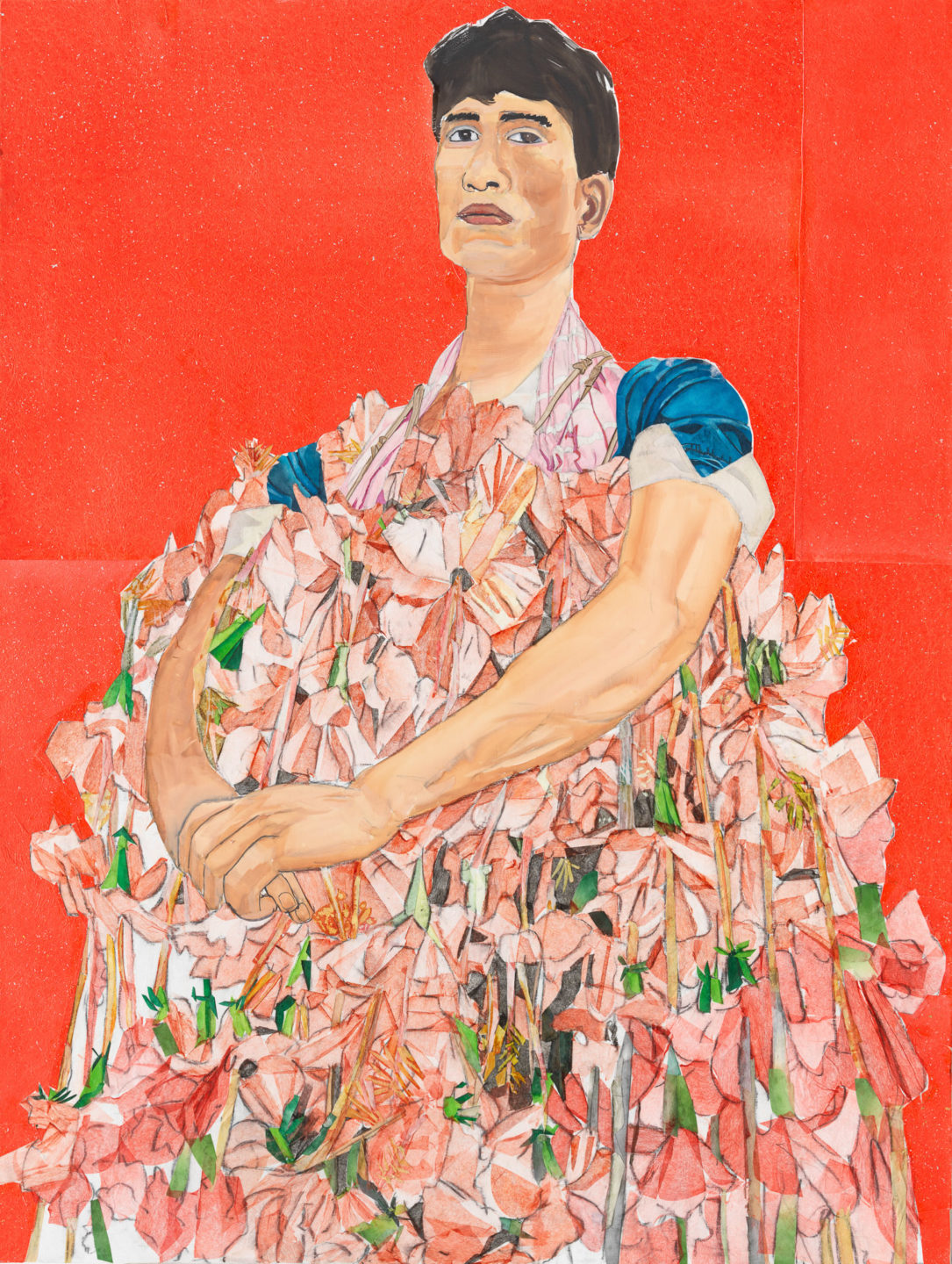
Collage with Japanese papers and watercolour paint on linen
125.7 x 94.6 cm
49 1/2 x 37 1/4 in
María Berrío, Phobos, 2024
More infoNew publication
Produced in close dialogue with the artist, this special volume expands on the exhibition’s themes. In his essay, A Call to the Stage, Siddhartha Mitter draws together the strands of concept, reference, material and process that define what he describes as Berrío’s ‘most tactile work yet.’ The compositional device of the vortex is one that Mitter allies with the ‘tumult of the world’, while the motif of the mask is explored through the social role of masking across cultures and ages. Mitter contends that Berrío’s practice, bridging timescales and worlds, asks us to actively engage with the present: ‘These paintings are a call to motion and movement. They want us to take cognisance of the forces that would turn us into spectators…’ A further focus is the artist’s use of Japanese papers in tandem with watercolour and inks and how in her ‘utterly distinctive, hybrid method… She has embraced her materials as a kind of partner.’ Tactility runs through the design of the book, by Atelier Dyakova, which features special papers selected by the artist, numerous details of the works in the exhibition, along with studio photography by Gautier Deblonde.
María Berrío provides a commentary around the thoughts and process that brought this new body of work into being, detailing her collaboration with Andrea Miller and her dance company GALLIM who, given costumes and props, improvised the movements that were, the artist explains, ‘not merely intriguing and beautiful, but something that began to take on a life of its own.’ Photographs of the collaboration are featured.
Also reproduced is a recent series of paintings, entitled A Feast for Ammit – a fictitious, three-act play devised by the artist that tells a story of intrigue, infatuation and, ultimately, tragedy. In these psychologically charged scenes costumed figures are seen against monochrome backgrounds, lending an intensity that mirrors the narrative’s heightened atmosphere of restless obsession and fatal desire. A commentary by the artist about this series concludes this very special publication, which is limited to 1000 copies.
Available for the special exhibition price of £65.00 (retail £80.00).
About the artist

María Berrío was born in Bogotá, Colombia in 1982 and lives and works in Brooklyn. Major solo exhibitions include María Berrío: The Children’s Crusade, ICA Boston, USA (2023) and María Berrío: Esperando mientras la noche florece (Waiting for the Night to Bloom), The Norton Museum of Art, West Palm Beach, Florida, USA (2021). Recent institutional group exhibitions include Spirit in the Land, Nasher Museum of Art at Duke University, Durham, North Carolina, USA (2023), travelling to Pérez Art Museum, Miami, USA (2024) and Cummer Museum of Art & Gardens, Jacksonville, USA (2024–2025); Women Painting Women, The Modern, Fort Worth, Texas, USA (2022); A Natural Turn, The DePaul Art Museum, Chicago, USA (2022); Born in Flames: Feminist Futures, Bronx Museum of the Arts, New York, USA (2021); Labor: Motherhood & Art in 2020, University Art Museum at New Mexico State University, Las Cruces, USA (2020).
Works by the artist will feature in the forthcoming exhibition Forbidden Territories: 100 Years of Surreal Landscapes, on view at The Hepworth Wakefield, UK (23 November 2024–21 April 2025).
Berrío’s work is in permanent collections including the Albertina, Vienna, Austria; Brooklyn Museum, New York, USA; Crystal Bridges Museum of American Art, Bentonville, AR, USA; Dallas Museum of Art, USA; Des Moines Art Center, Iowa, USA; Ford Foundation Center for Social Justice, New York, USA; Hirshhorn Museum and Sculpture Garden, Washington DC, USA; Institute of Contemporary Art (ICA), Boston and Miami, USA; Los Angeles County Museum of Art (LACMA), USA; The Metropolitan Museum of Art, New York, USA; Museum of Contemporary Art Chicago, USA; Nasher Museum of Art at Duke University, Durham, USA; Pennsylvania Academy of the Fine Arts, Philadelphia, USA; Pérez Art Museum, Miami, Florida, USA; Philadelphia Museum of Art, Pennsylvania, USA; Speed Art Museum, Louisville, USA; Weatherspoon Museum of Art at the University of North Carolina, Greensboro, USA; Whitney Museum of American Art, New York, USA; Yuz Museum, Shanghai, China.
